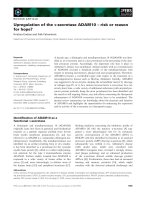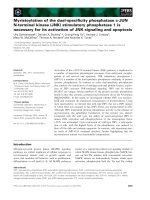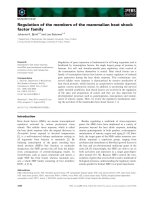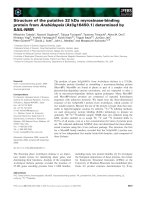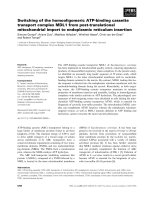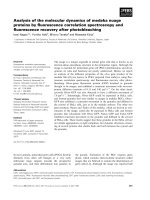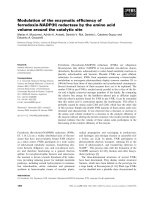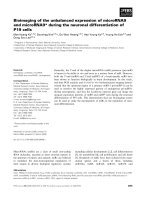Báo cáo khoa học: Interaction of the P-type cardiotoxin with phospholipid membranes pptx
Bạn đang xem bản rút gọn của tài liệu. Xem và tải ngay bản đầy đủ của tài liệu tại đây (349.37 KB, 9 trang )
Interaction of the P-type cardiotoxin with phospholipid membranes
Peter V. Dubovskii, Dmitry M. Lesovoy, Maxim A. Dubinnyi, Yuri N. Utkin and Alexander S. Arseniev
Shemyakin & Ovchinnikov Institute of Bioorganic Chemistry, Russian Academy of Sciences, Moscow, Russian Federation
The cardiotoxin (cytotoxin II, or CTII) isolated from cobra
snake (Naja oxiana) venom is a 60-residue basic membrane-
active protein featuring three-finger beta sheet fold. To assess
possible modes of CTII/membrane interaction
31
P- and
1
H-NMR spectroscopy was used to study binding of the
toxin and its effect onto multilamellar vesicles (MLV)
composed of either zwitterionic or anionic phospholipid,
dipalmitoylglycerophosphocholine (Pam
2
Gro-PCho) or
dipalmitoylglycerophosphoglycerol (Pam
2
Gro-PGro), res-
pectively. The analysis of
1
H-NMR linewidths of the toxin
and
31
P-NMR spectral lineshapes of the phospholipid as a
function of temperature, lipid-to-protein ratios, and pH
values showed that at least three distinct modes of CTII
interaction with membranes exist: (a) nonpenetrating mode;
in the gel state of the negatively charged MLV the toxin
is bound to the surface electrostatically; the binding
to Pam
2
Gro-PCho membranes was not observed; (b)
penetrating mode; hydrophobic interactions develop due to
penetration of the toxin into Pam
2
Gro-PGro membranes in
the liquid-crystalline state; it is presumed that in this mode
CTII is located at the membrane/water interface deepening
the side-chains of hydrophobic residues at the tips of the
loops 1–3 down to the boundary between the glycerol and
acyl regions of the bilayer; (c) the penetrating mode gives
way to isotropic phase, stoichiometrically well-defined CTII/
phospholipid complexes at CTII/lipid ratio exceeding a
threshold value which was found to depend at physiological
pH values upon ionization of the imidazole ring of His31.
Biological implications of the observed modes of the toxin–
membrane interactions are discussed.
Keywords: cytotoxin II (cardiotoxin); membrane binding
mode; multilamellar phospholipid vesicles;
31
P-NMR;
isotropic phase.
Understanding the physical principles underlying mem-
brane protein structure and dynamics advanced rapidly
during the past decade. A number of high resolution
membrane protein structures available is growing. How-
ever, all of them are either helical bundles or b-barrels [1].
An important question is whether new motifs would
emerge. The positive answer has been obtained by consid-
ering insertion of cytotoxins (CTs) into membranes.
CTs (Fig. 1A) are single chain all b-sheet proteins with a
common fold provided by four disulfide linkages forming a
globular head from which three major loops emerge [2,3].
Due to their cytotoxic and hemolytic activities it was
suggested [4,5] that CTs act on biological membranes. This
has been demonstrated comprehensively with membrane
models such as micelles, monolayers, liposomes [6–8].
Surface [9,10] and transbilayer [11–13] modes of the
insertion of CTs into membranes were suggested. CTs were
classified into P- and S-types [6]. The S-type CTs contain
Ser28 and are thought to insert only loop I into membranes.
The Pro30 residue is typical of the P-type CTs which
interact with membranes by all three loops [14]. Lytic
activity of CT molecules has been ascribed to a change
in their orientation at the membrane surface [10] or in
the positioning from a surface location to a transbilayer one
[13].
A recent theoretical study of the binding of S- and P-type
CTs to membranes suggested that P-type CTs are inserted
into membranes via the tips of the three loops while S-type
ones are inserted through the tip of the loop I only [15].
Experimental data supporting this hypothesis have been
found for the interaction of the P-type CTII (Fig. 1B) with
micelles [16] and phospholipid vesicles [17]. The effect of
CTII on phospholipid membranes was not studied. A wide-
line
31
P-NMR spectroscopy was used for this purpose in
this work.
Different phospholipid phases characterized by specific
modes of molecular motion result in specific line shapes
of chemical shift anisotropy (CSA)-dominated wideline
31
P-NMR spectra [7]. The induction by CTs of bilayer-
to-isotropic phase transitions in membranes composed of
anionic [18] or zwitterionic phospholipids [13] has been
shown. An analysis of redistribution of the intensities within
powder type
31
P-NMR spectra of MLV as a result of their
deformation by the magnetic field of the spectrometer was
performed and modulation of this effect by peptides [19],
CTs [20] in particular, was studied. In the present work
CTII/phospholipid interactions for MLV composed of
either zwitterionic Pam
2
Gro-PCho or anionic Pam
2
Gro-
PGro were analysed with this technique. These data were
Correspondence to A. S. Arseniev, Shemyakin & Ovchinnikov Institute
of Bioorganic Chemistry, 16/10 Miklukho-Maklaya str.,
V-437 Moscow, 117997 Russia. Fax: + 7 95 335 50 33,
E-mail:
Abbreviations: CSA, chemical shift anisitropy; CT, cytotoxin; L/P,
lipid to protein molar ratio; MLV, multilamellar vesicles; NaOAc,
sodium acetate; PtdCho, phosphatidylcholine; Pam
2
Gro-PCho,
dipalmitoylglycerophosphocholine; PtdGro, phosphatidylglycerol;
Pam
2
Gro-PGro, dipalmitoylglycerophosphoglycerol.
(Received 3 December 2002, revised 4 March 2003,
accepted 18 March 2003)
Eur. J. Biochem. 270, 2038–2046 (2003) Ó FEBS 2003 doi:10.1046/j.1432-1033.2003.03580.x
supplemented by
1
H-NMR data on the toxin binding to
MLV. Finally, conclusions about the modes of CTII/
membrane interaction and their relation to biological
activity were drawn.
Materials and methods
Purification of CTII
CTII from Naja oxiana snake venom was purified as
described previously [21]. Analytical RP-HPLC showed
that purity of the CTII preparations was 98%. The
phospholipase A
2
activity of CTII was found to be negli-
gibly small. In the presence of CTII and EDTA, the effects
of phospholipid degradation was not detected at all, even
after long incubation (> a week).
Sample preparation
31
P-NMR spectroscopy. The phospholipids used in the
work, namely 1,2-dipalmitoyl-sn-glycero-3-phosphocholine
(Pam
2
Gro-PCho) and 1,2-dipalmitoyl-sn-glycero-3-[phos-
pho-rac-(1-glycerol)] (Pam
2
Gro-PGro) were obtained com-
mercially (Avanti Polar Lipids, Alabaster, AL, USA) and
used without any further purification.
2
H
2
O(99.9%)was
from IZOTOP (St. Petersburg, Russian Federation),
sodium acetate (NaOAc), EDTA and KCl were from
REACHIM (Moscow, Russian Federation)
1
. NaOAc buffer
(0.2
M
) containing 10 m
M
EDTA, 150 m
M
KCl, in
2
H
2
O
(direct pH meter reading of 5.5) was used for the hydration
of phospholipids and dissolution of CTII.
Samples containing CTII/phospholipid mixtures were
prepared in the following way. NMR tubes (5 mm
outer diameter
2
, Norell Inc, Landisville, NJ, USA) were
loaded with 20 mg of the phospholipid powder. Fol-
lowing this, buffer (the amount of buffer added
provided at least 200 mol of water per mol of phos-
pholipid) or CTII dissolved in the buffer [to provide a
desired lipid to protein (L/P) molar ratio] was added.
The dispersion obtained was cycled thermally in the
range 20–50 °C and agitated mechanically to ensure its
homogeneity.
For experiments on pH titration, CTII/Pam
2
Gro-PGro
mixture (20 mg of Pam
2
Gro-PGro,
2
H
2
O/Pam
2
Gro-PGro
of 600 : 1 mol : mol) was prepared in
2
H
2
O containing
10 m
M
EDTA, 150 m
M
KCl without buffer. The pH
was adjusted by adding small aliquots of concentrated
NaOH or HCl solutions and pH values are given as direct
pH meter readings.
1
H-NMR spectroscopy. One milligram of CTII was
dissolved in 0.5 mL of 10 m
M
NaOAc (pH 5.5) buffer
containing 95% H
2
O, 5%
2
H
2
O, 10 m
M
KCl and 1 m
M
EDTA. The 25 m
M
stock solution of Pam
2
Gro-PCho or
Pam
2
Gro-PGro MLV were prepared in the same buffer.
After addition of the required amount of lipid to the toxin
solution, the mixture was cycled thermally and vortexed
before measurement as described above.
NMR data acquisition
NMR spectra were obtained on an 11.4 T Bruker DRX-
500 spectrometer (Germany) with
1
H- and
31
P-resonance
frequencies at x
0
/2p ¼ 500.13 and 202.5 MHz, respect-
ively, using a standard broad-band 5 mm probehead. The
magnetic field of the spectrometer was locked during
acquisition through
2
H
2
O contained in the samples. The
temperature of the samples was controlled by dry air and
monitored by the VT-system (BVT 3000) to an accuracy of
±0.1 °C. Chemical shifts were referenced to external 85%
H
3
PO
4
or internal HDO signal in the
31
P- and
1
H-NMR
spectra, respectively. The WATERGATE scheme was used
for water signal suppression in the
1
H-NMR spectra [22].
31
P-NMR spectra were recorded with the spin ½ Hahn
echo pulse sequence with full phase cycling of both
transmitter and receiver [23] using 90° pulse of 8 lsand
interpulse delay of 40 ls. The repetition time was 3–8 s, the
longer time being used at higher temperatures. A total of
1000–3000 scans were accumulated for each spectrum of
60 606 Hz spectral width. During acquisition, broadband
31
P-
1
H decoupling was applied. The spectral processing
was carried out with
WINNMR
software supplied by
the spectrometer manufacturer (Bruker). The 2K time
domain points were zero-filled to 4K data points multiplied
by the Lorentzian (broadening factor of 1–5 Hz; this
distorted minimally the line-shape of spectra) and Fourier
transformed.
Fig. 1. Schematic representation of three-fingered b-sheet structure of
CTII (A) and its amino-acid sequence (B). In (A) the finger numbers, the
N- and C-termini together with the hydrophilic residues situated at the
membrane/water interface (dotted line) are marked. In (B) the disulfide
bridges are shown in connecting lines, residues at the tips of the three
loops interacting with dodecylPCho micelle at pH 5.5 [16] are shown
in bold type.
Ó FEBS 2003 Cardiotoxin/phospholipid interactions (Eur. J. Biochem. 270) 2039
Line shape simulation
Theoretical
31
P-NMR spectra were calculated and fitted to
the experimental ones within program
MATHEMATICA
(ver-
sion 4.0, Wolfram Research). Theoretical spectra were
represented as the convolution of the Lorentzian, Gaussian
(or their linear combination) and function of angular
distribution for ellipsoids [19]. This procedure takes into
account that MLV of phospholipids in the magnetic field of
the spectrometer adopt ellipsoidal shapes [19,24]. In case
where the experimental spectra were combinations of
isotropic and broad lines, the adjustable parameters in the
simulation protocol were: components of the tensor of
chemical shift anisotropy, integral intensity, the semiaxis
ratio of ellipsoidal MLV, halfwidths of Lorentzian or
Gaussian lineshapes and their proportion. At the attained
level of signal-to-noise ratio this procedure ensured the error
of the spectral decomposition into isotropic and broad
components to be within 2–4%.
Molecular graphics
Fig. 1 was drawn with the
MOLMOL
program [25].
Results and discussion
In the present study
31
P-NMR spectroscopy was used to
evaluate the effects of CTII on MLV and thus, in
combination with the structural data on the protein
[16,21], to investigate its membrane binding modes.
The extent of the toxin binding to MLV was determined
by
1
H-NMR spectroscopy as the first step.
Binding of CTII to Pam
2
Gro-
P
Gro vs. Pam
2
Gro-
P
Cho MLV
1
H-NMR spectra. The binding of peptides to lipid vesicles
is seen in the
1
H-NMR spectra of peptide/lipid mixtures as
broadening and/or chemical shift changes of the peptide
proton signals because the binding affects overall rotational
correlation time and environment of a peptide [26]. The
signals in the
1
H-NMR spectra of CTII in aqueous solution
at 30 °C are sharp (Fig. 2). Their spectral intensities were
attenuated by the addition of Pam
2
Gro-PGro MLV while
line widths and chemical shifts remained unchanged (Fig. 2,
from top to bottom). Evidently, this corresponds to the case
when the exchange rate between free and lipid bound toxin
falls into the slow time scale (with an upper boundary of the
order of s
)1
). In this case only the ÔfreeÕ peptide is seen
spectroscopically while the
1
H-NMR signals of the mem-
brane-bound CTII are extremely broad due to low overall
rotational correlation time of the complex. When the L/P
ratio becomes > 10 : 1, CTII signals in the spectra are
not observed (Fig. 2, bottom), i.e. all CTII is bound to
Pam
2
Gro-PGro. It is of note that the
31
P-NMR spectra of
the samples corresponding to L/P ¼ 7, 10, 12 (Fig. 2) were
similar to spectrum taken at L/P ¼ 14 (see below)
3
. Thus the
bilayer structure of Pam
2
Gro-PGro membranes in the gel
phase is intact at these conditions. Raising the temperature
above the gel to liquid crystalline phase transition of
Pam
2
Gro-PGro ( 41 °C) at L/P ¼ 14 : 1 results in the
domination of the isotropic signal in the
31
P-NMR spectra
4
.
However no signal of free CTII was observed in
1
H-NMR
spectrum under these conditions. This means that the
transition of Pam
2
Gro-PGro to an isotropic phase is not
accompanied by a redistribution of CTII between aqueous
and lipid phases.
The titration of CTII with MLV of zwitterionic
Pam
2
Gro-PCho at 30 and 50 °C, i.e. at the temperatures
of the gel and liquid crystalline phase, respectively, to an L/P
ratio of 50 : 1 did not influence high-resolution
1
H-NMR
spectra of the toxin (spectra are not shown). This indicates
that binding of CTII to MLV of Pam
2
Gro-PCho is
negligibly small and, thus, electrostatic attraction of the
positively charged CTII molecule to a negatively charged
membrane is required for the binding of the toxin.
31
P-NMR spectra. The partitioning of the P-type CTs into
zwitterionic membranes was shown to depend upon surface
pressure in the outer membrane leaflet [27]. CTs partitioned
into lyso-PtdCho micelles [6], sonicated vesicles of sphingo-
myelin [28] or egg PtdCho [17] but not 100 nm unilamellar
extruded vesicles of dimyristoyl glycero phosphocholine
5
(P. V. Dubovskii & M. A. Dubinnyi, unpublished obser-
vations).
1
H-NMR data of the present study showed that
CTII remains in aqueous phase of Pam
2
Gro-PCho MLV.
Indeed, the
31
P-NMR spectra of Pam
2
Gro-PCho/CTII
dispersions (spectra are not shown) were found to be
identical to those of pure Pam
2
Gro-PCho dispersions in
the temperature range studied (30–55 °C). Thus, both
1
H-NMR and
31
P-NMR data argue for the absence of
CTII binding to Pam
2
Gro-PCho.
The influence of CTII binding to MLV of Pam
2
Gro-
PGro on the lineshapes of the
31
P-NMR spectra of the
phospholipid was studied at different temperatures and
L/Ps. These observations were made in the temperature
interval (30–55 °C) encompassing the gel-to-liquid crystal
transition of Pam
2
Gro-PGro bilayers ( 41 °C), while the
L/P ratio varied from 7 to 200.
In Fig. 3, the
31
P-NMR spectra of the MLV of pure
Pam
2
Gro-PGro and in the presence of CTII (L/P ¼ 129 : 1)
arecompared.Thespectrainthegelstate(30 °C) exhibit no
difference while in the spectra corresponding to the liquid
Fig. 2.
1
H-NMR spectra of CTII in the presence of increasing amounts
of Pam
2
Gro-PGro MLV (from top to bottom) at 30 °C. The L/P ratio is
indicated on the right. The impurity peaks are marked with asterisks.
2040 P. V. Dubovskii et al. (Eur. J. Biochem. 270) Ó FEBS 2003
crystalline state (50 °C) the redistribution of the intensities
of the high-field peak and the low-field shoulder are clearly
seen. It is known that the negative diamagnetic susceptibility
anisotropy of the fatty acyl chains of the phospholipid
molecules causes a preferential orientation of the long
molecular axis perpendicular to the external magnetic field
[24,29,30]. As a result, MLV of phospholipids adopt shape
of a prolate ellipsoid instead of a sphere. Spectral simula-
tions of the lineshape of the
31
P-NMR spectra allow to
extract the ratio of ellipsoid long/short axis (c/a) [31,32].
This ratio is dependent upon hydration of Pam
2
Gro-PGro
which changes with the amount of CTII added. To elucidate
theeffectofCTIIonthedeformationofMLVat50°C, the
c/a values calculated for MLV of Pam
2
Gro-PGro solvated
by either buffer alone or buffered toxin solution are plotted
in Fig. 4A against L/P. The addition of the buffer or CTII
aliquots resulted in the same phospholipid hydration in
both samples.
The decrease of L/P below of 20 : 1 induces nearly
spherical shape of Pam
2
Gro-PGro MLV (c/a 1), i.e.
CTII inhibits the deformation of MLV by the magnetic field
(Fig. 4A).
Addition of CTII to MLV of Pam
2
Gro-PGro in the
liquid crystalline phase results in the appearance of the
isotropic signal in the
31
P-NMR spectra. Dependence of
the amount of isotropic signal in the
31
P-NMR spectra of
Pam
2
Gro-PGro upon amount of CTII added was deter-
mined at 50 °C (Fig. 4B). The main feature of this
dependence is an existence of a threshold of the L/P ratio
below which the transition of bilayer to isotropic phase is
initiated. At L/P > 20 the amount of the isotropic signal is
zerowithinanexperimentalerror( 3%). At lower L/P
ratios the amount of isotropic signal increases nearly
proportionally with amount of CTII added. The complete
transformation of bilayer into isotropic phase at 50 °Cis
Fig. 3.
31
P-NMR spectra of Pam
2
Gro-PGro
MLV (water/Pam
2
Gro-PGro ¼ 230 : 1,
mol/mol) in the presence (left) of CTII (L/P ¼
129 : 1) and its absence (right) at 30 °C
(bottom), 50 °C (top). The spectra are scaled to
the intensity of the high-field peak. The com-
puter-simulated shapes of MLV at 50 °Care
shown in the top.
Fig. 4. Change in the ellipticity c/a of Pam
2
Gro-PGro MLV with an
amount of CTII (L/P and L/
2
H
2
O) or buffer (L/
2
H
2
O) added (A) and
the amount of isotropic signal in the
31
P-NMR spectra of Pam
2
Gro-
PGro/CTII dispersions (B). The experiments were carried out at 50 °C.
Ó FEBS 2003 Cardiotoxin/phospholipid interactions (Eur. J. Biochem. 270) 2041
observed at L/P ratio of 10:1(Fig.4B).Itisinteresting
to note that under these conditions (pH 5.5) CTII bears a
net positive charge of 10 and thus CTII/Pam
2
Gro-PGro
complexes forming isotropic phase are electrically neutral.
The temperature variation of
31
P-NMR spectra of
Pam
2
Gro-PGro in the presence of CTII at L/P ratio of
14:1isshowninFig.5.
The decomposition of the spectra (see example in Fig. 5)
gives the amount of the isotropic component. Its tempera-
ture dependence is featured by a sigmoidal shape (Fig. 6A).
The temperature of the half-transition of bilayer to isotropic
phase (Fig. 6A) coincides that of the gel-to-liquid crystal
transition of Pam
2
Gro-PGro MLV. The CSA values of
Pam
2
Gro-PGro bilayers in the presence of CTII across the
whole temperature range studied (30–55 °C) were similar to
their respective values in the absence of the toxin. Thus the
average conformation of the head group in Pam
2
Gro-PGro
bilayers is insensitive to the presence of CTII under the
chosen experimental conditions. This does not contradict a
suggestion of an insertion of CTII between the negatively
charged polar PtdGro groups. Similar observations were
made in studies of positively charged peptides such as
polymyxin B [33], melittin [34], gramicidin S [35].
6
In all those
cases an increase of peptide concentration in PtdGro bilayers
did not affect
7
the
31
P CSA values of bilayers but lead to the
occurence of an isotropic peak in the
31
P NMR spectra.
Under conditions chosen (L/P ¼ 14 : 1) the magnetic
field induced deformation of MLV of Pam
2
Gro-PGro was
determined in the temperature range of 30–55 °Candthe
values obtained were compared to those for pure Pam
2
Gro-
PGro (Fig. 6B). It is seen that CTII extinguishes the
temperature dependence of the deformation of Pam
2
Gro-
PGro MLV observed in the absence of the toxin. These data
support the above conclusion on hampering of the defor-
mation of Pam
2
Gro-PGro MLV in the magnetic field by
CTII.
pH-dependence of the CTII/Pam
2
Gro-PGro interaction
The only group of CTII which changes its ionogenic state in
the physiological pH range is the imidazole ring of His31
residue (Fig. 1A). This group is at the membrane-binding
site of CTII [16] and thus might influence deepening of CTII
into membrane. Indeed, the amount of the isotropic signal
in the
31
P-NMR spectra of Pam
2
Gro-PGro/CTII mixture
(Fig. 7A) showed a characteristic pH-dependence. The pK
a
value of 6.1 of this process (Fig. 7B), is close to the value of
5.8 found for His31 of CTII in dodecylPCho micelle [16].
Thus, the neutralization of His31 residue results in the
increase of the deteriorating effect of the toxin onto
Pam
2
Gro-PGro bilayers.
It was shown recently [36] that CTII molecule changes
its disposition in dodecylPCho micelle depending on the
ionization state of His31 residue. By the change of the
ionogenic state of the imidazole ring from a protonated state
to a deprotonated one, the molecule of CTII inserts loop 3
more deeply into the micelle. The inserted volume of CTII
molecule within the micelle and within the membrane
increases when the imidazole group of His31 becomes
neutral. This is reflected in the pH-dependence of the ability
of CTII to induce an isotropic phase in the membranes of
Pam
2
Gro-PGro.
Modes of CTII interaction with the phospholipid
membranes
CTII was characterized in detail in aqueous solution by
NMR spectroscopy [21]. This toxin has two slowly inter-
converting forms called ÔmajorÕ and ÔminorÕ [21]. They have
a Val7-Pro8 peptide bond in trans-orcis-configuration,
respectively. Both ÔmajorÕ and ÔminorÕ formsofCTIIarenot
Fig. 5. Temperature dependence of the
31
P-NMR spectra of Pam
2
Gro-
PGro (molar ratio of water/Pam
2
Gro-PGro is 200 : 1) in the presence
of CTII at L/P ¼ 14 : 1. Theoretical spectrum corresponding to the
experimental one taken at 38 °C is shown on the right with the
decomposition bands drawn in broken lines.
Fig. 6. Temperature dependence of the amount of isotropic signal (A)
and of the MLV deformation (B). In (A) L/P ¼ 14 : 1. In (B) data for
Pam
2
Gro-PGro (diamonds) and Pam
2
Gro-PGro/CTII mixture
(L/P ¼ 14 : 1) (triangles) are shown. The molar ratio of water/Pam
2-
Gro-PGro in the samples was 200 : 1. The ellipsoidal shape of MLV
with semiaxes a and c was assumed in the computer simulations of the
data in (B). The vertical bars correspond to the error in the parameter
estimation.
2042 P. V. Dubovskii et al. (Eur. J. Biochem. 270) Ó FEBS 2003
bound to zwitterionic membranes of Pam
2
Gro-PCho at the
membrane hydration levels used in the present study ( 200
water molecules per lipid molecule).
The observations of the present study agree with a
previous suggestion that CTs interact with membranes by a
combination of electrostatic and hydrophobic forces [5]. In
this respect the interaction of CTII with negatively charged
membranes is similar to that of other basic peptide toxins:
thionin, purothionins, crambin, viscotoxin and delta-haemo-
lysin [37,38]. The data from this suggest that the modes of
CTII interaction with the membranes can be described as
follows (Table 1).
Mode 1: Attracted to the membrane surface (Table 1). It
was suggested [39] that a positively charged peptide can be
attracted by a negatively charged membrane–water interface
due to electrostatic interaction and then partitioned
into membrane hydrophobically. It is likely that CTII is
immobilized by Pam
2
Gro-PGro in the gel state without
hydrophobic partitioning.
1
H-NMR study of CTII
interaction with MLV of Pam
2
Gro-PGro at 30 °C showed
(Fig. 2) that at L/P > 10 : 1 all CTII is bound to lipid. At the
same time
31
P-NMR data indicated that bilayer structure of
Pam
2
Gro-PGro liposomes is not disturbed at 30 °C (Fig. 5).
This suggests that all lipid surface is covered by CTII
molecules at L/P 10 : 1 as a further decrease of L/P
results in the appearance of unbound CTII (see Fig. 2, L/P
ratios below 10 : 1). Assuming that Pam
2
Gro-PGro
molecules occupy the same surface area in the gel state of
thebilayerasPam
2
Gro-PCho, i.e. 0.48 nm
2
[40] the CTII
molecule would have 4.8 nm
2
accessible surface area on
the bilayer at L/P ¼ 10 : 1. The maximal cross-section of
CTII molecule perpendicular to its long axis is 5nm
2
and
thus no more than one toxin molecule per 10 lipids can be
accommodated on the surface of Pam
2
Gro-PGro MLV in
the gel phase. Thus at L/P ¼ 10 : 1 the Pam
2
Gro-PGro
liposomes in the gel phase are covered with CTII in a carpet-
like fashion suggested for cecropins [41] and thionins [42]. It
is of note that the membrane charge is fully compensated by
the charge of CTII at these conditions.
Mode 2: Partitioned (inserted) state (Table 1). In the
liquid crystalline phase of Pam
2
Gro-PGro membrane the
hydrophobic partitioning of CTII is favoured. In the case
of the P-type CTs the insertion is accomplished via the tips
of three hydrophobic loops (fingers) of the molecule
[14–16,43]. The tightly bound water molecule in the
second loop of these CTs provide W-shape to this loop
[16,21,43,44] and the tips of the loops 1–3 are joined into a
continuous hydrophobic column. The modelling of CTII
binding with negatively charged membranes suggested that
the only ÔmajorÕ form of CTII is energetically favoured to
insert into membranes [15]. The mode of the insertion is
similar to one described for CTII bound to zwitterionic
dodecylPCho micelles [16]. The depth of the penetration is
determined by the width of the hydrophobic motif of CTII
molecule ( 1 nm) and disposition of positively charged
side-chains which (Fig. 1, lysines 4,5,12,23,50, arginine 36)
are bound to the negatively charged groups of the lipid
molecules at the lipid bilayer/water interface.
The liquid crystalline bilayer of Pam
2
Gro-PGro can
accomodate a definite number of CTII molecules
(L/P 20 : 1, Fig. 4B) without induction of an isotropic
phase. The gel to liquid crystal transition is accompanied by
an 0.16 nm
2
increase of the surface area per lipid molecule
in Pam
2
Gro-PCho bilayer [40] and we assume the same
value for bilayers of Pam
2
Gro-PGro. Thus, the surface area
occupied by 20 molecules of Pam
2
Gro-PGro upon transi-
tion from gel to liquid crystalline phase increases by
0.16 · 20 ¼ 3.2 nm
2
. This value is smaller than the
molecular area of 5 nm
2
occupied by a single molecule of
CTII on the surface of a dodecylPCho micelle [16].
This suggests that insertion of CTII into Pam
2
Gro-PGro
membrane is likely to cause expansion of the membrane.
Mode 3: Isotropic phase (Table 1). When concentration
of CTII in the liquid crystalline membranes of Pam
2
Gro-
PGro exceeds a threshold value (L/P 20 : 1), the
liposomes are not able to accommodate CTII further and
Fig. 7. pH-dependence of the
31
P-NMR spectra of Pam
2
Gro-PGro/
CTII (14 : 1) dispersions at 50 °C (A), the anisotropic component in the
spectra is shown with broken line, the isotropic signal is truncated. (B)
The amount of the isotropic signal plotted vs. pH and approximated
by the best nonlinear fit for the determination of pK
a
value.
Ó FEBS 2003 Cardiotoxin/phospholipid interactions (Eur. J. Biochem. 270) 2043
are transformed into an isotropic phase with L/P ratio of 10.
The induction of this phase by CTs in anionic membranes
was suggested to be due to formation of stoichiometrically
well defined electrically neutral complexes of CT/
phospholipid having inverted micellar structure [18,45].
This observation seems to be valid for CTII/Pam
2
Gro-
PGro mixtures too.
Biological implications
It is well known that CTs preferentially target and disrupt
bilayers that are rich in acidic phospholipids on the
extracellular side of the plasma membrane [46]. This effect
was related to ability of CTs to induce formation of an
isotropic lipid phase [19,45]. At a lower concentration, at
which cytotoxic effect is less pronounced, CTs modulate
Na
+
and Ca
2+
ion fluxes acting on specific membrane
channels [47]. This effect can be attributed to CTs bound to
the lipid bilayer with the tips of three fingers. We conclude
from this work that CTs influence the bending elastic
modulus of the membrane and, hence, the transbilayer
pressure profile originating from the stiffening of lipid
molecules in the polar but not in the acyl region of
the membrane. (In this respect the influence of CTs on the
membrane stiffness is opposite to the action of the
cholesterol [48] which is ubiquitous in the membranes of
animal cells.) The membrane stiffness is important for
functioning of membrane receptors and ion channels [49].
Thus a deleterious effect of low CT doses on living cells
might be due to insertion of CTs into membranes (see mode
2, Table 1) resulted in improper functioning of the ion
channels and receptors.
Acknowledgements
This work was supported partially by the Ministry of Science and
Technology of Russian Federation and by the Russian Foundation of
Basic Research (RFBR) grants 00-04-55024, 00-15-97877, 01-04-48548.
References
1. White, S.H., Ladokhin, A.S., Jayasinghe, S. & Hristova, K. (2001)
How membranes shape protein structure. J. Biol. Chem. 276,
32395–32398.
2. Dufton, M.J. & Hider, R.C. (1988) Structure and pharmacology
of elapid cytotoxins. Pharmacol. Ther. 36, 1–40.
3. Kumar, T.K., Jayaraman, G., Lee, C.S., Arunkumar, A.I.,
Sivaraman,T.,Samuel,D.&Yu,C.(1997)Snakevenomcardio-
toxins-structure, dynamics, function and folding. J. Biomol.
Struct. Dyn. 15, 431–463.
4. Dufourcq, J. & Faucon, J.F. (1978) Specific binding of a cardio-
toxin from Naja mossambica mossambica to charged phospholi-
pids detected by intrinsic fluorescence. Biochemistry 17, 1170–1176.
5. Vincent, J.P., Balerna, M. & Lazdunski, M. (1978) Properties of
association of cardiotoxin with lipid vesicles and natural mem-
branes. A fluorescence study. FEBS Lett. 85, 103–108.
6. Chien, K.Y., Chiang, C.M., Hseu, Y.C., Vyas, A.A., Rule, G.S. &
Wu, W.G. (1994) Two distinct types of cardiotoxin as revealed
by the structure and activity relationship of their interaction
with zwitterionic phospholipid dispersions. J. Biol. Chem. 269,
14473–14483.
Table 1. Modes of CTII/Pam
2
Gro-PGro interaction.
No Mode
a
Lipid phase Conditions
1 Gel T < 41 °C
L/P P 10 : 1
2 Liquid crystalline T > 41 °C
L/P P 20 : 1
3 Isotropic T P 41 °C,
L/P < 20 : 1
a
The number of lipid molecules in the membrane (only upper leaflet is shown) does represent
8
the stoichiometry of the CTII/lipid interaction.
The coordinates of CTII molecule correspond to those calculated in dodecylPCho micelle (code of 1FFJ). Only backbone atoms are shown.
2044 P. V. Dubovskii et al. (Eur. J. Biochem. 270) Ó FEBS 2003
7. Watts, A. (1998) Solid-state NMR approaches for studying the
interaction of peptides and proteins with membranes. Biochim.
Biophys. Acta 1376, 297–318.
8. Maget-Dana, R. (1999) The monolayer technique: a potent tool
for studying the interfacial properties of antimicrobial and mem-
brane-lytic peptides and their interactions with lipid membranes.
Biochim. Biophys. Acta 1462, 109–140.
9. Ksenzhek, O.S., Gevod, V.S., Omel’chenko, A.M., Semenov,
S.N., Sotnichenko, A.I. & Miroshnikov, A.I. (1978) Interaction of
the cardiotoxin from the venom of the cobra Naja naja oxiana with
phospholipid membrane model system. Molekulyarnaya Biologiya
12, 1057–1065.
10. Bougis, P., Rochat, H., Pieroni, G. & Verger, R. (1981) Penetra-
tion of phospholipid monolayers by cardiotoxins. Biochemistry 20,
4915–4920.
11. Lauterwein, J. & Wu
¨
thrich, K. (1978) A possible structural basis
for the different modes of action of neurotoxins and cardiotoxins
from snake venoms. FEBS Lett. 93, 181–184.
12. Bilwes, A., Rees, B., Moras, D., Menez, R. & Me
´
nez, A. (1994)
X-ray structure at 1.55 A
˚
of toxin gamma, a cardiotoxin from
Naja nigricollis venom. Crystal packing reveals a model for
insertion into membranes. J. Mol. Biol. 239, 122–136.
13. Sue, S.C., Rajan, P.K., Chen, T.S., Hsieh, C.H. & Wu, W. (1997)
Action of Taiwan cobra cardiotoxin on membranes: binding
modes of a beta-sheet polypeptide with phosphatidylcholine
bilayers. Biochemistry 36, 9826–9836.
14. Dauplais, M., Neumann, J.M., Pinkasfeld, S., Menez, A. &
Roumestand, C. (1995) An NMR study of the interaction of
cardiotoxin gamma from Naja nigricollis with perdeuterated
dodecylphosphocholine micelles. Eur. J. Biochem. 230, 213–220.
15. Efremov, R.G., Volynsky, P.E., Nolde, D.E., Dubovskii, P.V. &
Arseniev, A.S. (2002) Interaction of cardiotoxins with membranes:
a molecular modeling study. Biophys. J. 83, 144–153.
16. Dubovskii, P.V., Dementieva, D.V., Bocharov, E.V., Utkin, Y.N.
& Arseniev, A.S. (2001) Membrane binding motif of the P-type
cardiotoxin. J. Mol. Biol. 305, 137–149.
17. Dubinnyi, M.A., Dubovskii, P.V., Utkin, Y.N., Simonova, T.N.,
Barsukov, L.I. & Arseniev, A.S. (2001) ESR study of the inter-
action of cytotoxin II with model membranes. Russian J. Bioorg.
Chem. 27, 102–113.
18. Picard, F., Pezolet, M., Bougis, P.E. & Auger, M. (1996) Model of
interaction between a cardiotoxin and dimyristoylphosphatidic
acid bilayers determined by solid-state
31
P NMR spectroscopy.
Biophys. J. 70, 1737–1744.
19. Picard, F., Paquet, M.J., Levesque, J., Belanger, A. & Auger, M.
(1999)
31
P NMR first spectral moment study of the partial mag-
netic orientation of phospholipid membranes. Biophys. J. 77,888–
902.
20. Picard, F., Pezolet, M., Bougis, P.E. & Auger, M. (2000) Hydro-
phobic and electrostatic cardiotoxin–phospholipid interactions as
seen by solid-state
31
P NMR spectroscopy. Can. J. Anal. Sci.
Spectr. 45, 72–83.
21. Dementieva, D.V., Bocharov, E.V. & Arseniev, A.S. (1999) Two
forms of cytotoxin II (cardiotoxin) from Naja naja oxiana in
aqueous solution: spatial structures with tightly bound water
molecules. Eur. J. Biochem. 263, 152–162.
22. Piotto,M.,Saudek,V.&Sklena
´
r
ˇ
, V. (1992) Gradient tailored
excitation for single-quantum NMR spectroscopy of aqueous
solutions. J. Biomol. NMR 2, 661–665.
23. Rance, M. & Byrd, R.A. (1983) Obtaining high-fidelity spin ½-
powder spectra in anisotropic media: phase cycled Hahn echo
spectroscopy. J. Magn. Reson. 52, 221–240.
24. Qiu, X., Mirau, P.A. & Pidgeon, C. (1993) Magnetically induced
orientation of phosphatidylcholine membranes. Biochim. Biophys.
Acta 1147, 59–72.
25. Koradi, R., Billiter, M. & Wu
¨
trich, K. (1996) MOLMOL: a
program for display and analysis of macromolecular structures.
J. Mol. Graphics 14, 51–55.
26. Jelicks, L.A., Broido, M.S., Becker, J.M. & Naider, F.R. (1989)
Interaction of the Saccharomyces cerevisiae alpha-factor with
phospholipid vesicles as revealed by proton and phosphorus
NMR. Biochemistry 28, 4233–4240.
27. Bougis, P., Tessier, M., Van Rietschoten, J., Rochat, H., Faucon,
J.F. & Dufourcq, J. (1983) Are interactions with phospholipids
responsible for pharmacological activities of cardiotoxins? Mol.
Cell Biochem. 55, 49–64.
28. Chien, K.Y., Huang, W.N., Jean, J.H. & Wu, W.G. (1991) Fusion
of sphingomyelin vesicles induced by proteins from Taiwan cobra
(Najanajaatra) venom. Interactions of zwitterionic phospholipids
with cardiotoxin analogues. J. Biol. Chem. 266, 3252–3259.
29. Seelig, J., Borle, F. & Cross, T.A. (1985) Magnetic ordering of
phospholipid membranes. Biochim. Biophys. Acta. 814, 195–198.
30. Speyer, J.B., Sripada, P.K., Das Gupta, S.K., Shipley, G. &
Griffin, R.G. (1987) Magnetic orientation of sphingomyelin–leci-
thin bilayers. Biophys. J. 51, 687–691.
31. Brumm, T., Mo
¨
ps, A., Dolainsky, C. & Bayerl, T.M. (1992)
Macroscopic orientation effects in broadline NMR-spectra of
model membranes at high magnetic field strength. A method
preventing such effects. Biophys. J. 61, 1018–1024.
32. Pott, T. & Dufourc, E.J. (1995) Action of melittin on the
DPPCcholesterol liquid-ordered phase: a solid-state
2
H- and
31
P-NMR study. Biophys. J. 68, 965–977.
33. Sixl, F. & Watts, A. (1985) Deuterium and phosphorus nuclear
magnetic resonance studies on the binding of polymyxin B to lipid
bilayer–water interfaces. Biochemistry 24, 7906–7910.
34. Monette, M. & Lafleur, M. (1995) Modulation of melittin-induced
lysis by surface charge density of membranes. Biophys. J. 68,
187–195.
35. Prenner, E.J., Lewis, R.N., Neuman, K.C., Gruner, S.M.,
Kondejewski, L.H., Hodges, R.S. & McElhaney, R.N. (1997)
Biochemistry 36, 7906–7916.
36. Arseniev, A.S. (2002) NMR, ESR and molecular modeling
of protein–membrane interactions. In Xx
th
International Confer-
ence on Magnetic Resonace in Biological Systems Toronto,
Canada.
37. Dufourc, E.J., Dufourcq, J., Birkbeck, T.H. & Freer, J.H. (1990)
Delta-haemolysin from Staphylococcus aureus and model
membranes. A solid-state
2
H-NMR and
31
P-NMR study. Eur. J.
Biochem. 187, 581–587.
38. Huang, W., Vernon, L.P., Hansen, L.D. & Bell, J.D. (1997)
Interactions of thionin from Pyrularia pubera with dipalmitoyl-
phosphatidylglycerol large unilamellar vesicles. Biochemistry 36,
2860–2866.
39. Beschiaschvili, G. & Seelig, J. (1990) Melittin binding to mixed
phosphatidylglycerol/phosphatidylcholine membranes. Biochem-
istry 29, 52–58.
40. Nagle, J.F. & Tristram-Nagle, S. (2000) Structure of lipid bilayers.
Biochim. Biophys. Acta 1469, 159–195.
41. Gazit, E., Boman, A., Boman, H.G. & Shai, Y. (1995) Interaction
of the mammalian antibacterial peptide cecropin P1 with phos-
pholipid vesicles. Biochemistry 34, 11479–11488.
42. Caaveiro, J.M., Molina, A., Rodriguez-Palenzuela, P., Goni,
F.M. & Gonzalez-Manas, J.M. (1998) Interaction of wheat
alpha-thionin with large unilamellar vesicles. Protein Sci. 7,
2567–2577.
43. Sun, Y.J., Wu, W.G., Chiang, C.M., Hsin, A.Y. & Hsiao, C.D.
(1997) Crystal structure of cardiotoxin V from Taiwan cobra
venom: pH-dependent conformational change and a novel mem-
brane-binding motif identified in the three-finger loops of P-type
cardiotoxin. Biochemistry 36, 2403–2413.
Ó FEBS 2003 Cardiotoxin/phospholipid interactions (Eur. J. Biochem. 270) 2045
44.Sue,S.C.,Jarrell,H.C.,Brisson,J.R.&Wu,W.G.(2001)
Dynamic characterization of the water binding loop in the P-type
cardiotoxin: implication for the role of the bound water molecule.
Biochemistry 40, 12782–12794.
45. Batenburg, A.M., Bougis, P.E., Rochat, H., Verkleij, A.J. & de
Kruijff, B. (1985) Penetration of a cardiotoxin into cardiolipin
model membranes and its implications on lipid organization.
Biochemistry 24, 7101–7110.
46. Gasanov, S.E., Alsarraj, M.A., Gasanov, N.E. & Rael, E.D.
(1997) Cobra venom cytotoxin free of phospholipase A and its
effect on model membranes and T leukemia cells. J. Membr. Biol.
155, 133–142.
47. Fletcher, J.E., Hubert, M., Wieland, S.J., Gong, Q.H. & Jiang,
M.S. (1996) Similarities and differences in mechanisms of cardio-
toxins, melittin and other myotoxins. Toxicon 34, 1301–1311.
48. Reinl, H., Brumm, T. & Bayerl, T.M. (1992) Changes of
the physical properties of the liquid-ordered phase with tempera-
ture in binary mixtures of DPPC with cholesterol. A
2
H-NMR,
FT-IR, DSC, and neutron scattering study. Biophys. J. 61, 1025–
1035.
49. Perozo, E., Kloda, A., Cortes, D.M. & Martinac, B. (2002) Phy-
sical principles underlying the transduction of bilayer deformation
forces during mechanosensitive channel gating. Nat. Struct. Biol.
9, 696–703.
2046 P. V. Dubovskii et al. (Eur. J. Biochem. 270) Ó FEBS 2003


